Text AI generators are a software that uses artificial intelligence to generate a variety of text content at the request of the user. With the help of text generators, authors can “order” ready-made blog posts, article structure and ideas, short descriptions for social networks, potential ideas for a working content plan, etc.
AI generators use a machine learning model and track text data from sources such as websites, books, articles. Based on this data, reproduce and improve content over time. In particular, generators hone grammar, sentence types, text structure, and word frequency.
With such well-known AI solutions, many marketologists, copywriters, content managers and other workers were able to create and plan text content for the site and social networks much faster. But, in order to create the desired text not only quickly, but also qualitatively, you need to choose the right tool. Therefore, this blog post will be made in the format of an experiment on 5 well-known AI generators.
A Comparative Guide to AI Writing Tools
The best AI generators are considered to be ChatGPT, Writesonic, Rytr, Copy.ai and Grammarly. In this table, we’ll provide a quick comparison of each of the most popular AI generators before testing each one.
Title | Best For | Price |
ChatGPT | Blog writing, article outlines | $20/month; limited free version |
Writesonic | Content marketing | Individual plan from $20/month |
Rytr | An affordable option for various purpose | Free plan available (10,000 characters/month); Unlimited plan from $9/month |
Copy.ai | Automatic content creation | $49/month; limited free plan |
Grammarly | Writing emails | $12/month (billed annually); limited free plan |
Despite the fact that each AI generator has its own purpose, we will check in practice what this or that tool is actually suitable for.
What Is The Main Task For AI Generators
We will conduct a small experiment and “order” each of the generators to write a children’s tale about the friendship between a cat and a dog. The given prompt for the AI generator looks like this:
“Please write a fairy tale for children aged 6-12 about how a cat and a dog were constantly quarreling, but then some kind of adventure happened, the cat and the dog found a solution and from that time became friends.”
The purpose of the experiment is to compare the writing characteristics of each of the generators and how human-like text is produced by each of them.
How AI Models are Trained for Unique Text Tasks
ChatGPT
ChatGPT is the first to go. This AI generator is probably one of the easiest to use. It is enough to register on the site via e-mail and start a new chat by entering prompts.
After entering prompt into the contact window, the artificial intelligence generated a long text about the adventures of a cat and a dog. It is interesting that ChatGPT chose the names for the main characters and independently chose which adventures they would go through. It is even interesting that the AI created a third character, gave them a name and individual lines.
It is also worth noting that the descriptions and quotes of the main characters correspond to the typical features of children’s stories about animals. However, the dialogues are still too sketchy and sometimes do not sufficiently reveal the traits of the characters themselves.
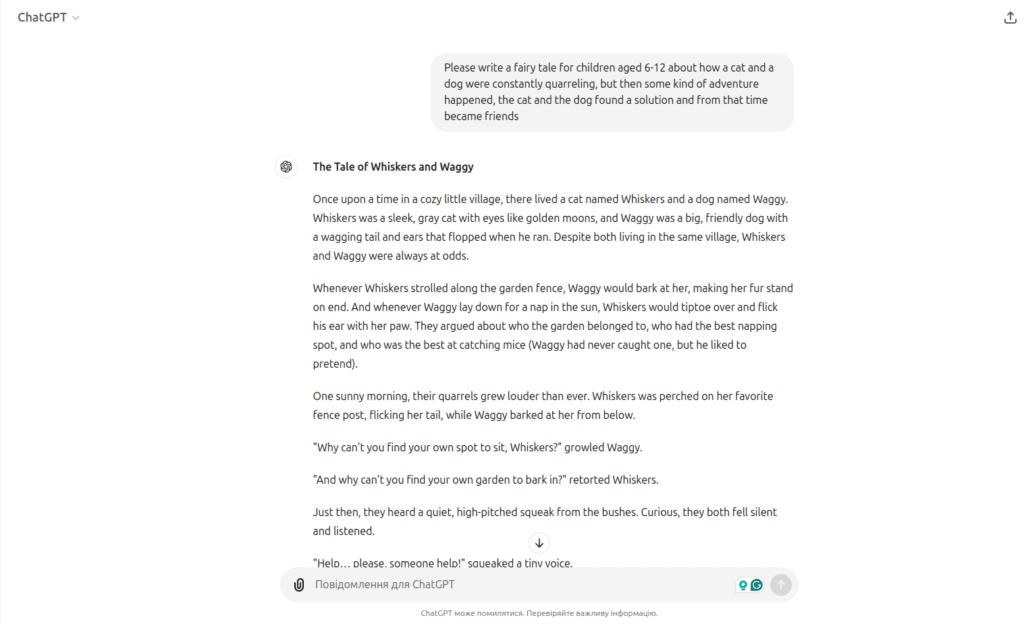
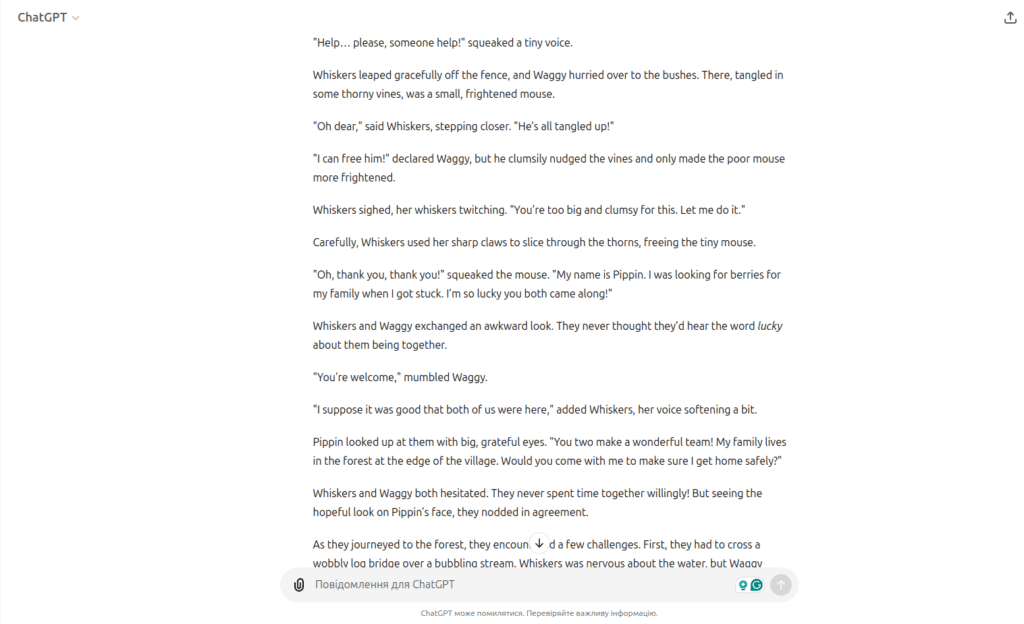
Writesonic
Unlike ChatGPT, Writesonic has a more comprehensive approach to text creation. Writesonic initially offers a free version or orders a demo version. Bank details are not required for the free version.
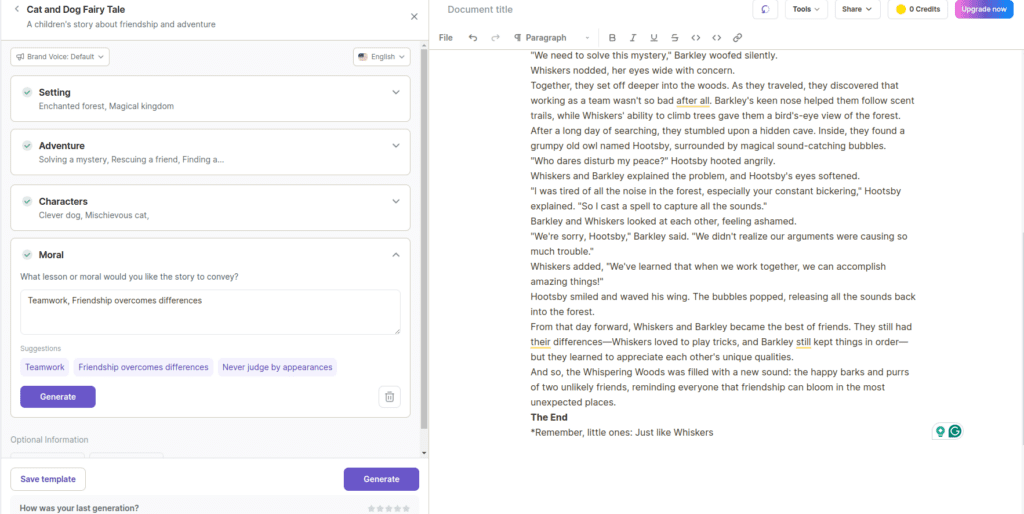
Similar to ChatGPT, this AI generator offers text generation via chat. But, after entering the prompt, Writesonic offers additional criteria for how the final text should look. The platform gives options for choosing the text language and branding voice. From the more specific ones related to our children’s fairy tale, the AI generator offers the user to choose the circumstances in which the main characters will be (enchanted forest, magical kingdom, cozy village, etc.), choose the type of story (solving a mystery, saving a friend, searching for treasures, etc.). A user can also choose the characters of the main characters and the final moral of the story.
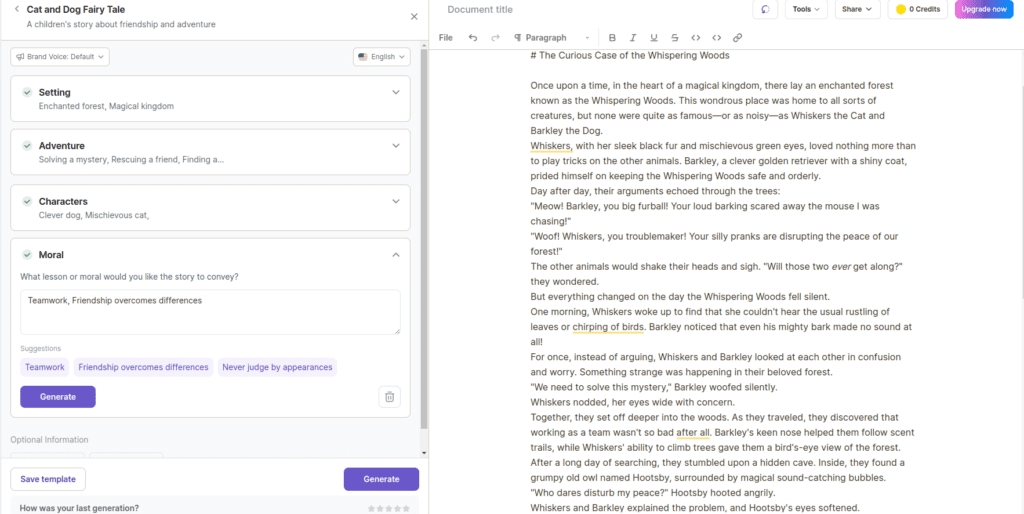
Indeed, these additional characteristics made the story more voluminous at the expense of better defined characters, making their initial conflict more alive and interesting. However, the main part, when the heroes go on a quest and investigate a mystery, is too concise and does not reveal enough how the heroes could still overcome their differences. Similarly to ChatGPT, Writesonic also independently chose the names for the main characters and added a third character who drives the plot.
However, the only major downside is that Writesonic has a word limit, so the conclusion of the story is left unfinished.
Rytr
Rytr is a fully accessible and free AI generator for those who create text content in any direction – from advertising texts to fiction. You can register on the platform through Google, Facebook, LinkedIn or directly on the site.
Next, a user goes through the stages of personalization, and goes to a window where he can write prompts. Rytr offers options for writing a variety of textual content, from the idea and structure of a blog post to a concise description of a YouTube video to song lyrics. When choosing a certain category, the user independently chooses the topic of the work, inserts keywords, the number of options (from one to three) and the level of creativity. Also, the user can choose the language of the future text and tone voice.
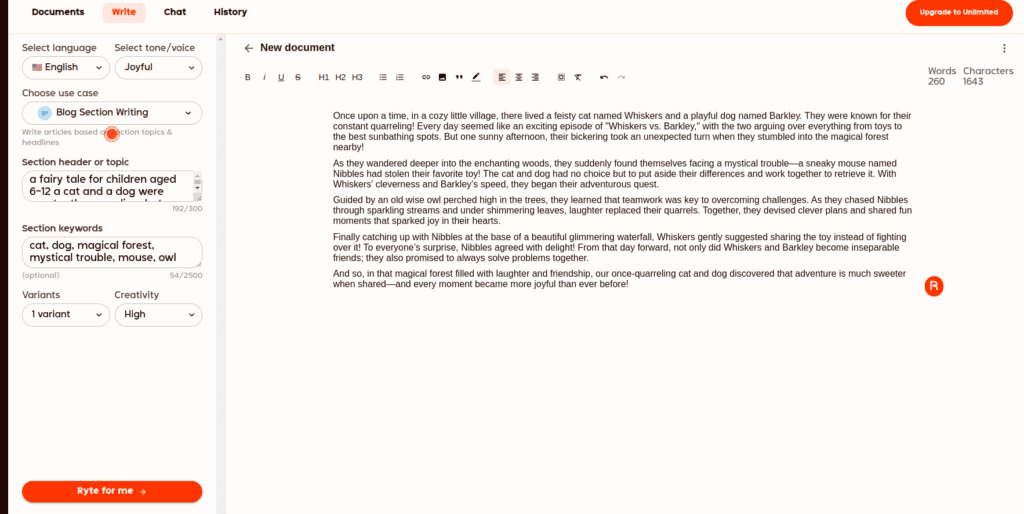
Like previous AI generators, Rytr also chooses names for characters, but these names are repetitive. Like Whiskers, a cat name that is repeated in all three generators. Or the dog’s name, which is also repeated in other AI generators.
In terms of length of text, Rytr has written the shortest story of all, under 300 words. And this story has no quotes from the characters, and the story itself is written more like an advertising text than a real children’s fairy tale.
Copy.ai
The next AI generator to be tested by us is Copy.ai. Like its counterparts, this platform has both paid and free versions. After registration and several stages of personalization, a user goes to the default page, which shows several options for generating content – from a standard chat to tracking a marketing workflow. For the experiment, we will use a standard chat that has a universal purpose, which is ideal for our fairy tale.
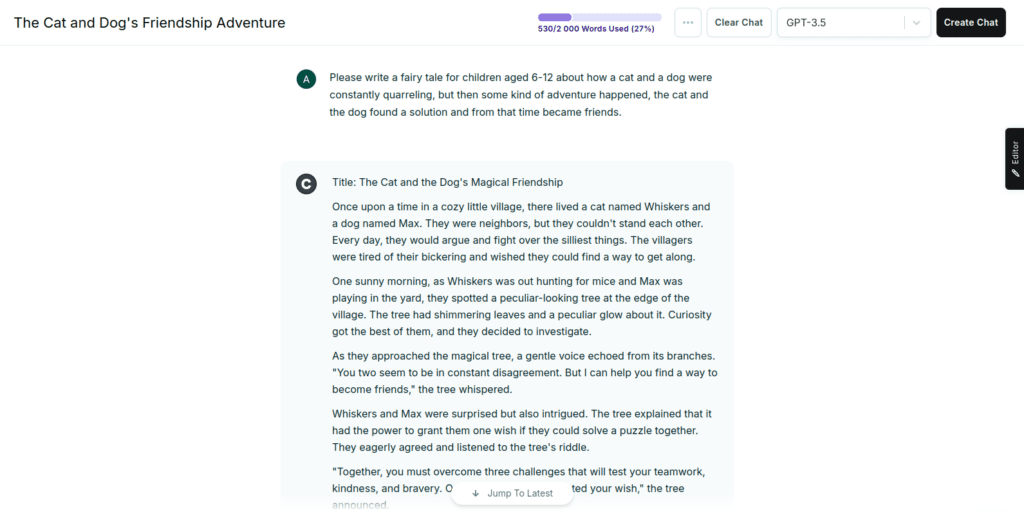
Copy.ai in its free version has a limit of 2000 words for content generation, but these words turned out to be enough to create our fairy tale. Again, the cat’s name was repeated in the story. For the dog, AI came up with a new name, Max, which had not been repeated before. As in all the previous stories, the AI generator has added a new character to the story that moves the plot, and it is not a mouse or an owl, but a magical tree that has to solve the differences between the dog and the cat.
The story contains quotes from the characters, but Copy.ai did not specify why the characters constantly quarrel, the plot itself is written rather chaotically and too concisely. There is also a lack of descriptions of the characters and their personalities.
Grammarly
And the last AI generator we will check is Grammarly AI assistant. It is available to a user without registration, and to generate the needed text, he must go through several stages to clarify the order. The user specifies the theme, story details, intonation, and the program begins the generation process.
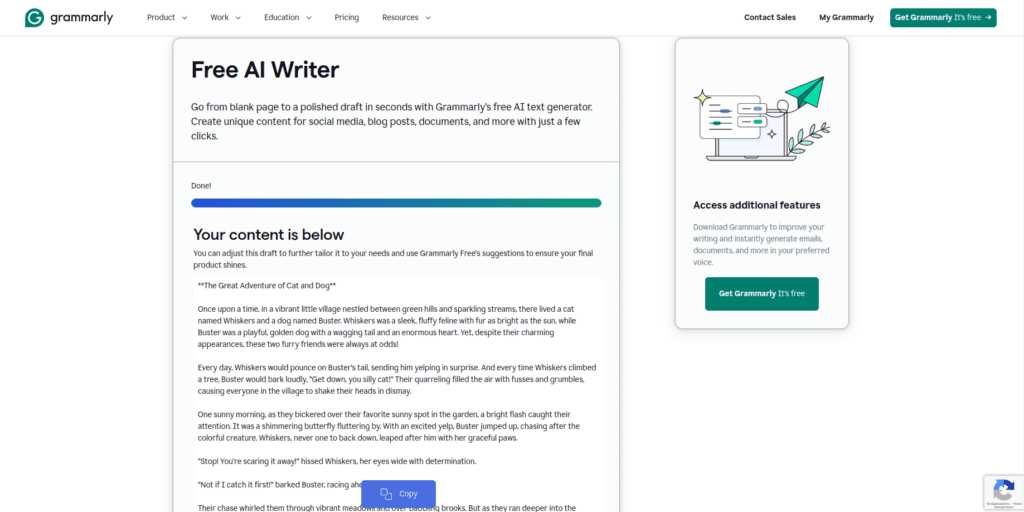
Among all fairy tales that have been written with the help of artificial intelligence, this children’s fairy tale is the longest. The sentences are quite well formulated and as close as possible to human ones. The dialogues, in particular, are well written here and harmoniously combined with the action that takes place in the fairy tale. As for the main characters, the cat’s name is repeated, and the dog’s name is new again. Descriptions of the appearance and characters of the characters are present here, and the conflict itself and its resolution are quite well thought out and written out in a fairy tale.
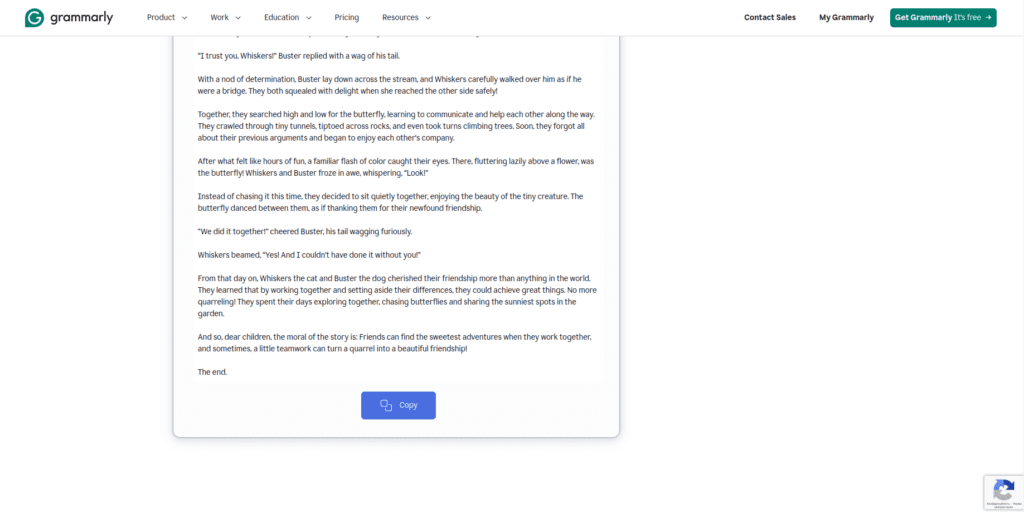
Text generators allow you to quickly create the desired text and save a lot of time, but for the most optimal result, you need to choose the best one. Having conducted a small experiment on writing an ordinary children’s fairy tale, we can tell the AI generator by Grammarly did the best, because it is his story that looks like a full-fledged finished work. The same thing can be said about Writesonic’s work, which also stood out for its character descriptions and dialogue. ChatGPT also managed quite well, but the story from Rytr was still the least successful and more like a short advertising text.
Having reviewed the key functions and features of the above-mentioned AI generators, we can conclude that the choice of the right AI generator depends on your specific needs: some generators are suitable for creative writing of ideas, others are suitable for concise advertising texts and descriptions for videos on social networks.


